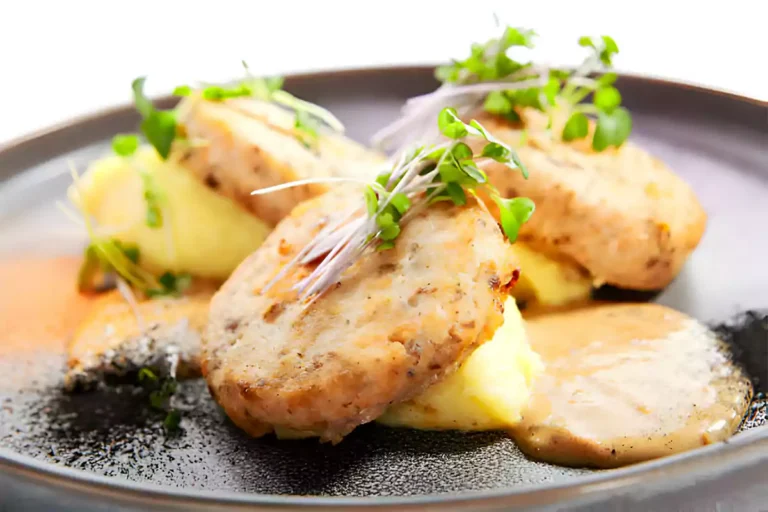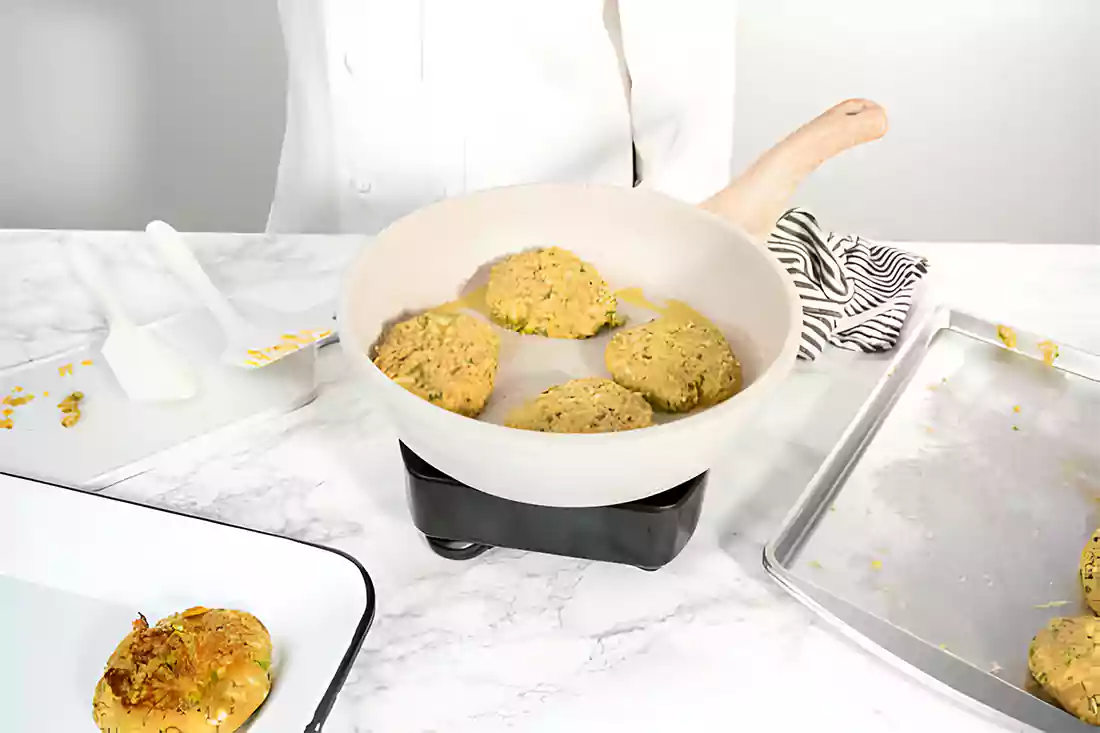Introduction to Crab Cakes
Crab cakes stand as a testament to the simplicity and elegance of seafood cuisine. Originating from the shores of Maryland, these delectable patties have woven their way into the fabric of culinary tradition, celebrated for their rich flavor and tender texture. At their core, crab cakes champion the exquisite lump crab meat, elevating it with a symphony of seasonings and a delicate balance of binders to create a dish that’s both hearty and refined, much like the ultimate crab cake recipe featured on our site.
The Origins of Crab Cakes: A Maryland Delicacy
Crab cakes originated in the Chesapeake Bay area’s early settlements, where seafood was integral to daily life. English settlers introduced the concept, adapting their fish cake recipes to the plentiful crab available in the region. These crab patties evolved into a quintessential part of Maryland cuisine, embodying the state’s maritime legacy.
Exploring Regional Crab Cake Varieties Across the U.S.
Crafting the Perfect Crab Cakes: Ingredients and Preparation
Key Components of Authentic Crab Cakes
Fresh Lump Crab Meat
The star of the show, lump crab meat, is non-negotiable for authenticity. This premium meat, known for its tender texture and sweet flavor, is carefully picked from the crab’s body, offering the best quality for our culinary masterpiece.
Mastering Crab Cake Flavor: Binding and Seasoning
To hold our star ingredient together, we turn to eggs and mayonnaise, the unsung heroes of the crab cake world. These binding agents are crucial for creating a cohesive mixture that doesn’t fall apart during cooking. But remember, the goal is to complement, not overshadow, the crab meat, so use these ingredients sparingly to maintain the cakes’ delicate texture.
Seasonings (Old Bay, Dijon Mustard, Parsley)
Seasonings are where we can get creative, adding depth and character to our crab cakes, drawing inspiration from diverse recipes like the gingerbread bundt cake for unique flavor combinations. Old Bay seasoning, a Maryland staple, brings a warm, spicy undertone, while Dijon mustard adds a tangy kick. Fresh parsley not only introduces a pop of color but also a fresh, herbal note that balances the richness of the crab meat.
Step-by-Step Preparation
Mixing Ingredients
Begin by whisking together the eggs, mayonnaise, Dijon mustard, Worcestershire sauce, Old Bay, and a pinch of salt. This mixture will serve as the flavorful glue that binds our crab cakes. Then, gently fold in the lump crab meat and panko breadcrumbs, being careful not to break up those precious lumps of crab. This step is all about finesse; we want to maintain the integrity of the crab meat for that ultimate bite.
Shaping and Refrigerating
Once mixed, shape the mixture into generous patties and lay them on a baking sheet. Here’s a pro tip: refrigerate the crab cakes for at least an hour before cooking. This crucial step helps them set, ensuring they don’t fall apart when introduced to the heat.
Cooking Techniques: Pan-Frying vs. Baking
When cooking crab cakes, you have choices. Pan-frying creates a crispy outside and moist inside, while baking offers a lighter option, highlighting the succulent crab meat. Whichever method you pick, aim for a golden brown finish for that perfect texture. Our crab cakes blend fresh ingredients with culinary finesse, honoring tradition and care. Let the natural flavors shine, making each bite a tribute to the sea’s richness.
Serving and Enjoying Crab Cakes: Variations and Suggestions
Crab cakes, much like the regions they hail from, come in a variety of styles and flavors, each adding its unique twist to this classic dish. Moreover, the way you serve crab cakes can elevate them from a simple meal to a gourmet experience. Let’s explore the rich tapestry of regional variations and the myriad of serving suggestions that can complement these delectable seafood treats.
Exploring Crab Cake Variations: From Maryland to the Pacific Northwest
Maryland Crab Cakes
Maryland crab cakes are the gold standard, known for their high crab meat content and minimal filler. The emphasis is on the freshness and quality of the lump crab meat, with just enough binding to hold the cake together. Seasoned with Old Bay and a hint of mustard, these crab cakes are a pure expression of the Chesapeake Bay’s bounty.
Other Regional Takes
As we venture beyond Maryland, we encounter a world of variations, similar to how different regions influence dishes like the baked chicken tacos, adding their unique twist, and for those who prefer a lighter version, baked crab cakes offer a delicious alternative In Louisiana, for example, crab cakes might take on a Cajun flair, infused with bold spices and served alongside a remoulade sauce. The Pacific Northwest might favor Dungeness crab, offering a sweeter taste profile. Each region brings its local ingredients and culinary traditions to the table, creating a diverse spectrum of flavors and textures.
Serving Suggestions
Perfect Pairings: How to Serve Your Crab Cakes
A classic Maryland crab cake is often served with a side of tangy tartar sauce and fresh lemon wedges. The tartar sauce, with its creamy texture and pickled undertones, complements the sweetness of the crab, while a squeeze of lemon adds a bright, acidic contrast that enhances the overall flavor profile.
Side Dishes: Hush Puppies, Cornbread
Enhance your crab cakes with hush puppies or cornbread for a satisfying meal. Alternatively, opt for a fresh green salad with a simple vinaigrette for a lighter touch. With endless variations in crab cake recipes, from classic Maryland simplicity to regional innovations, there’s something for everyone. The right accompaniments elevate your crab cakes into a memorable dining experience, highlighting the natural flavors of the lump crab meat. Whether you prefer tradition or experimentation, ensure each bite celebrates the sea’s bounty.
Nutritional Information
When indulging in the savory delight of crab cakes, it’s also worth considering their nutritional profile. Beyond their irresistible taste and texture, crab cakes offer a range of health benefits, thanks to the star ingredient: lump crab meat. Let’s delve into the nutritional aspects of crab cakes and how they can fit into a balanced diet.
Health Considerations
Crab meat is not only delicious but also packed with valuable nutrients, akin to the health benefits explored in our Amish macaroni salad recipe, where fresh ingredients play a central role, and you can learn more about the health benefits of crab meat and how it contributes to a balanced diet. It’s a lean source of protein, essential for muscle repair and growth, making crab cakes an excellent choice for those looking to maintain or build muscle mass. Moreover, crab meat is rich in omega-3 fatty acids, known for their heart-health benefits and their role in reducing inflammation.
Caloric Content
The caloric content of crab cakes can vary depending on the preparation method and the amount of filler used. Traditional Maryland crab cakes, with their minimal filler, tend to be lower in calories compared to versions with more breadcrumbs or other fillers. Pan-frying in oil will add to the calorie count, whereas baking offers a lighter alternative without sacrificing flavor.
Nutritional Benefits of Crab Meat
FAQs (Based on “People Also Ask”)
Frequently Asked Questions
What Makes a Crab Cake Authentic?
An authentic crab cake is all about the crab, with lump crab meat taking center stage, echoing the emphasis on quality ingredients found in our cinnamon bread recipe guide. The hallmark of authenticity lies in using fresh, high-quality crab meat and minimal fillers. Traditional seasonings like Old Bay, a hint of mustard, and fresh parsley can enhance the crab’s natural flavor without overpowering it. Authentic crab cakes are typically pan-fried to a golden brown, offering a crispy exterior with a tender, moist interior.
Can I Use Canned Crab Meat?
How Do I Prevent Crab Cakes from Falling Apart?
Advanced Tips and Tricks
Delve further into perfecting the crab cake craft, uncovering chef’s secrets and nuances that transform this dish into a gourmet delight. Discover advanced techniques in ingredient selection, filler reduction, and cooking mastery to elevate your crab cakes to superior status.
Chef’s Tips for Perfect Crab Cakes
Selecting the Best Crab Meat
The choice of crab meat can make or break your Seafood Patties. Opt for fresh, lump crab meat for its superior texture and flavor. Fresh crab meat should smell clean and slightly briny, not fishy. If fresh isn’t available, the next best option is pasteurized crab meat kept refrigerated, but steer clear of canned crab meat with preservatives that can alter the taste and texture.
Minimal Use of Fillers
The essence of a great crab cake lies in its ability to showcase the crab meat. Use fillers like breadcrumbs or crackers sparingly, just enough to bind the cakes together. The filler should never overshadow the flavor of the crab. A good rule of thumb is to aim for a mixture where the crab meat is still the star, with fillers playing a very supporting role.
Cooking Tips to Retain Moisture
For perfect crab cakes, focus on cooking method and temperature. Pan-fry over medium heat for a moist inside and crispy crust. Or bake at a higher temp for less time, ensuring a golden exterior without drying. Elevate your crab cake game by honoring the crab’s integrity, mastering ingredient roles, and enhancing flavors with smart cooking techniques. Create crab cakes that honor tradition and tantalize taste buds.
Conclusion and Call to Action
In our exploration of crab cakes, we’ve delved into their history, regional varieties, and crafting techniques. From selecting premium crab meat to perfecting flavor balance, each aspect contributes to this beloved dish’s allure. With their refined blend of crab and seasonings, crab cakes make a versatile and sophisticated choice for any dining setting, epitomizing seafood cuisine’s excellence.
Recap and Final Thoughts
Explore crab cake origins, embrace regional variety, master cooking techniques, and elevate with quality ingredients for a gourmet delight.
Encouragement to Try Making Crab Cakes at Home
We encourage you to take these insights and tips into your kitchen, and for those seeking more inspiration, Life is but a Dish offers a variety of crab cake recipes to explore. Experiment with different variations, play with flavors, and make the crab cake your canvas for culinary creativity. Whether you stick to the traditional Maryland style or infuse your local flavors, the key is to celebrate the crab meat in all its glory.

